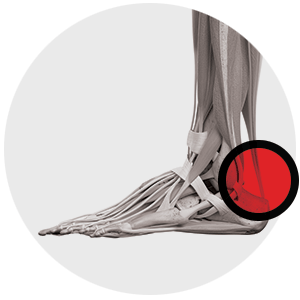Achilles Dysfunction

Achilles Tendon Dysfunction
There are many problems that can occur with the Achilles tendon. Tendonitis can be insertional where the tendon attaches to the bone or non-insertional. Acute rupture of the tendon can occur and that usually does involve operative intervention.
Insertional Tendonitis for what is known as Haglund’s Deformity
Inflammation of the Achilles tendon where it inserts into the calcaneus (heel bone) is known as insertional tendonitis. It is often associated with an abnormal bony prominence just deep to the tendon known as a Haglund’s deformity or “pump bump”. The insertion of the Achilles can then calcify, adding to the bump. This may play a role in rubbing on the deep aspect of the tendon to cause pain and inflammation in the soft tissues. It can then rub on footwear and even prevent the wearing of certain shoes.
Operative Management
Operative management involves a good operation. There are 4 stages to this operation:
- Releasing the Achilles tendon of the bone and cleaning up the end of the tendon;
- Removing any associated bursitis in the back of the ankle;
- Resecting and removing the bony prominences to help eliminate the Haglund’s deformity and the pump bump;
- Safely reattaching the tendon. Dr Rao uses a product known as a SpeedBridge (Arthrex®).
Non-Insertional Tendonitis
Non-insertional tendonitis inflammation occur in and around the Achilles tendon higher up the leg from the heel. It often occurs with running and jumping sports. It can also occur with overuse syndrome, postural problems, poor footwear and underlying inflammatory conditions. The abnormal lump is felt higher up the leg in the Achilles tendon region.
Operative Management
Open surgery involves removing the lump in the Achilles tendon. The Achilles tendon is repaired, however it is often common for you to require an FHL(flexor hallucis longus) tendon transfer. This tendon normally functions to flex the big toe. It is not missed as other muscles take over the function of the big toe.
Acute Achilles Tendon Rupture
Rupture of the Achilles tendon may follow a prodromal phase of tendinosis. Often you may have experienced some pain in your Achilles tendon for a few weeks to months prior to it actually rupturing. The actual event that does cause the rupture is mechanical stress associated with rapid loading of the already tense tendons such as lunging forward from a standing start, unexpected stepping in a hole, jumping from a height. Whatever the cause, patient describe a sudden pain like being kicked in the back of the leg (or sometimes even shot in the back of the leg). They may also hear an audible pop.
Operative Management
Operative management involves the use of minimally invasive tools. Dr Rao uses the Arthrex claw with the use of a device known as the PARS. This is stands for percutaneous Achilles repair system. Dr Rao passes 3-4 heavy sutures across your tendon and then anchors them into our heel bone. This is an excellent procedure that allows full weight bearing within 2 weeks.
Risks and Complications
A good result can be expected in 90%-95% of patients. The risks and complications will be assessed and discussed with you. The re-rupture rate, however, with this technique is less than 2% and nerve damage is uncommon due to the fact that the wounds are much smaller than what they previously used to be. Wound infection is also a rarity.
Recovery Times
In terms of hospital stay:
- 2-3 nights in hospital;
- Rest and elevation for 2 weeks;
- Crutches and frame for 2-3 weeks;
- Boot for 8-10 weeks;
- Non-weight bearing for the first 2 weeks, then full weight bearing with a walking aid between weeks 2-8.
Rehabilitation:
- Commences at week 3 with your local physiotherapist;
- Getting back to sport takes approximately training at 3 months, an back to sport at 4 months
- Time off work:
- for seated jobs, 3 weeks
- for standing jobs around 8-10 weeks
- Foot swelling for 8-10 weeks.
Meet Dr Rao
Dr Rao is a Newcastle Orthopaedic surgeon who specialises in all aspects of foot and ankle surgery. He graduated from medicine at the University of Sydney and trained as an orthopaedic surgeon in Newcastle and also in Queensland.
He also undertook further training by way of fellowship with world famous Dr Terry Saxby in Brisbane in 2008. He has also conducted further training by attending numerous courses overseas, in Thailand, the USA and right across Australia.

